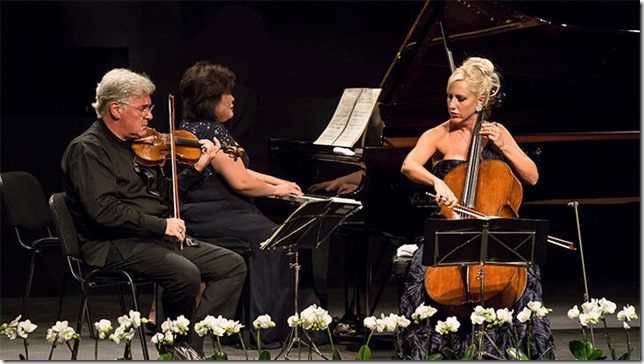The Zukerman Trio, from left: Pinchas Zukerman, Angela Cheng and Amanda Forsyth. (Photo by Nicholas Brodard)
By Robert Croan
There was an atmosphere of disorder and disorganization about the Zukerman Trio’s performance on the Broward Center Classical Series in the Amaturo Theater on Sunday.
It had little to do with the excellent performers — violinist Pinchas Zukerman, cellist Amanda Forsyth and pianist Angela Cheng — who played just two works for the combination generally known as “piano trio”: Dvořák’s so-called Dumky Trio (Op. 90) on the first half, and Beethoven’s Archduke Trio (Op. 97) on the second. Each is an important work in the standard chamber music canon.
The concert started late, with doors to the very pleasant Amaturo auditorium opening less than 10 minutes prior to the announced performance time. Once inside, there were no printed programs to be had. While the individual selections had been listed in some advance publicity, most people did not know what they were listening to, or how many movements to expect before the end.
This Dvořák trio happens to be a structurally disjointed work, in eight sections, some played without pause, others coming to an end before a brief hiatus. As a result, there was distracting applause at every point when it seemed the work might be coming to an end. Adding to the confusion, I’m told that a pre-concert lecture covered Beethoven before Dvořák (which is reasonable, since the Beethoven work is chronologically earlier), leading some concert-goers to believe that they were listening to Beethoven on the first half.
A makeshift printed sheet was delivered at intermission, clarifying the basic information, though one had to be enterprising and a bit aggressive to obtain a copy. Zukerman apparently learned about the lack of programs and announced the pertinent information at the start of the second half.
All that said, it was a musically rewarding evening. Dvořák’s trio is a mature work, composed in 1891, shortly after his Eighth Symphony, and like that orchestral masterpiece, heavily influenced by Czech and Bohemian folk music. “Dumky,” in fact, is a term originating in folk music, describing a sad song that alternates abruptly with high-spirited outbursts. Dvořák used this principle to break from the traditional sonata form/four-movement structure and create a style reflecting the sounds of his homeland. One of this composer’s greatest accomplishments was the integration of traditional classical style with the flavor and almost visual evocations of his own country. He was to do this again for what he believed to be American folk music when he visited the United States a few years later.
The Zukerman Trio gave an intense, though at times erratic reading of the trio, taking some time to warm up. Zukerman’s tone was seductively sweet throughout, his phrasing inevitably sculpted with loving care. Cellist Forsyth had some sour moments at the start, eventually coming into her own with plush tone and incisive rhythmic sense. Some of her intermittent solo phrases provided the loveliest segments.
Cheng’s keyboard work was virtuosic and commanding, often dominating the ensemble, but the piano (a rich-toned Steinway) seemed not quite in tune with the strings as the work progressed. The problem was fixed by some fine-tuning during intermission, and the instrument sounded splendid on the second half. Still, despite the excellent individual contributions, the Dumky Trio came through more as a combination of three accomplished soloists, than a true interplay.
In their rendition of Beethoven’s Archduke Trio, which followed, just about everything seemed right. Here, the three players found an equality of purpose that conveyed their love of making music together. The elements congealed into a whole that was greater than any individual part.
This is a work of considerable gravitas, composed the same year as the Eroica Symphony, with which it shares many characteristics. The Archduke spans the gamut of emotions, yet it is immediately accessible, never obtuse or obscure.
The title refers to Archduke Rudolf of Austria, a Habsburg nobleman who was Beethoven’s student (in piano and composition), friend and loyal patron. The opening movement is a grandiose expansion of sonata form, which the performers delivered with clarity of phrasing and texture, each theme becoming a character in the drama.
The scherzo that follows is infectiously happy, and the ensemble reveled in the opportunities to share the fun, while in the songful Andante variations of the third movement, Zuckerman’s honeyed violin and Forsythe’s meaty cello sound contrasted exquisitely with the sensitive, crisp keyboard sonorities that are the glue holding it all together.
The finale was once more ebullient and graceful, a vehicle for the instrumentalists’ best talents and a cheerful conclusion to the program. The enthusiastic audience was rewarded with a fluffy miniature by Fritz Kreisler for an encore.
